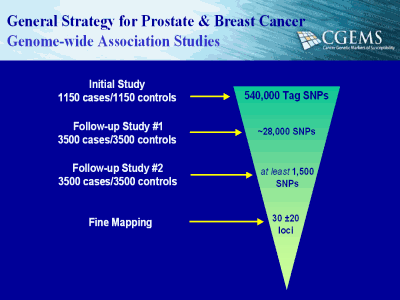 |
In the past year the excitement about genetic
susceptibility has reached fever pitch with the opportunity not only to look
at candidate genes under the lamp post so to speak, but also to interrogate
the entire genome for genome-wide association studies utilizing the
haplotype tagging of SNPs, the molecular epidemiology infrastructure that
was developed here at NCI, and the consortial arrangements that have been
made with the extramural community. A strategy called CGEMS, which stands
for Cancer Genetic Markers of Susceptibility, has been developed with an
initial focus on prostate and breast cancer. And we’re planning soon to move
to pancreas cancer and to lung cancer, lymphoma, bladder cancer and others
for which we have specimens as well as epidemiologic data. The studies are
led by Stephen Chanock and Giles Thomas and a wonderful staff at the Core
Genotyping Facility together with a team approach that involves many others
across NCI, including those in DCCPS and DCP and as well as the extramural
research community. Using Illumina technology, the initial scan of 540K
tag-SNPs has involved over a thousand cases, each of prostate and breast
cancers and an equal number of controls. In what is called here the “column
of truth”, a stepwise progression of follow up and replication studies
narrows the number of SNPs that can be significantly related to cancer risk.
The analytical challenges have been great, and we’re lucky to have a group
of outstanding statisticians to guide our efforts. At the end of the process
a relatively small number of genetic loci remain for re-sequencing and for
functional and other studies that will identify the causal variants and
pathways, including those that may be related to the genomic alterations
that are found in tumor tissue that is collected in some of our studies.
However, the downstream work goes far beyond what our division and the
Genotyping Facility can accomplish, and we’re hopeful that the basic and
clinical scientists in the intramural program will see some fresh
opportunities to advance our understanding of cancer etiology and biology,
and enhance the prospects for new preventive, diagnostic, and therapeutic
interventions. |
